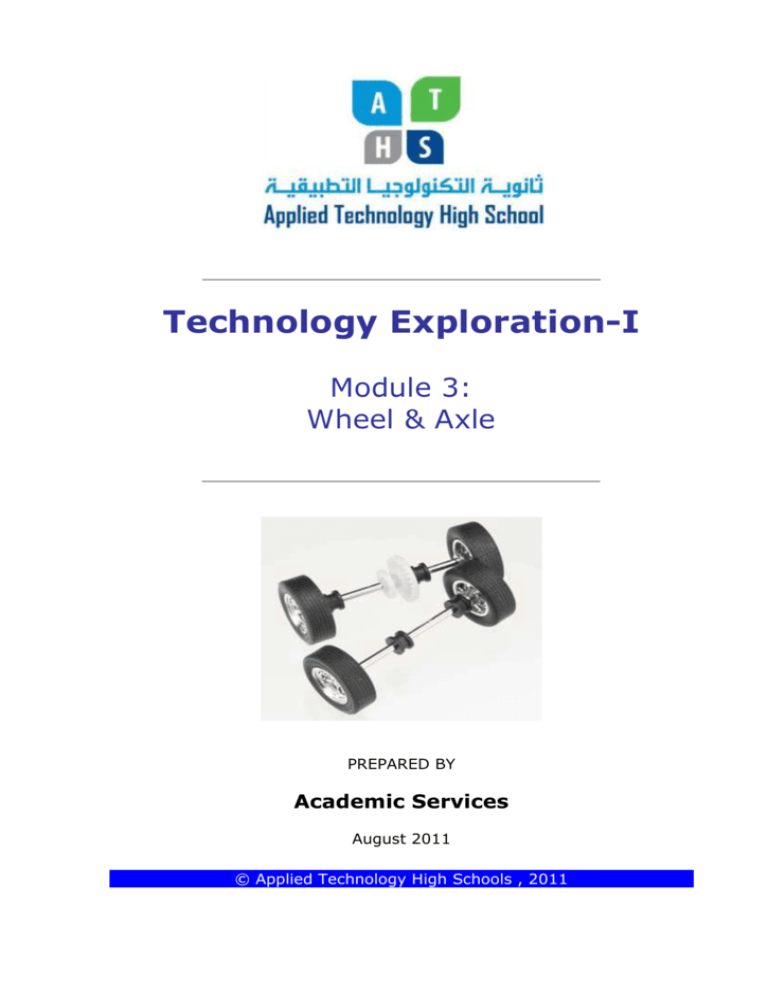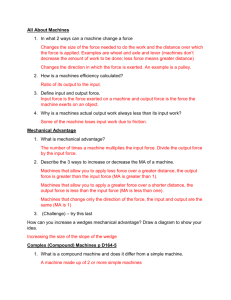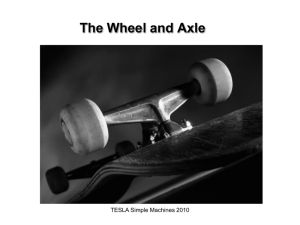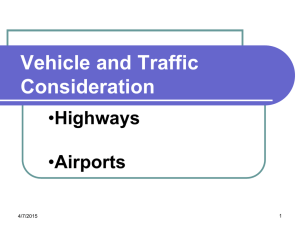File
advertisement

Technology Exploration-I Module 3: Wheel & Axle PREPARED BY Academic Services August 2011 © Applied Technology High Schools , 2011 ATM-0910 Technology Exploration-I Module 3: Wheel & Axle Module Objectives After the completion of this module, the student should be able to: 1. Identify wheel and axle. 2. Recognize some applications of wheel and axle. 3. Calculate the mechanical advantage of wheel and axle. Module Contents 1. Introduction to Wheel and Axle 3 2. Mechanical Advantage 4 3. Practical Task 6 4. Wheel & Axle Worksheet 8 5. Additional Resources 2 Module 3: Wheel and Axle 10 ATM-0910 Technology Exploration-I Wheel & Axle 3.1 Introduction to Wheel & Axle Wheel and axle is another type of simple machines that we utilize daily. Definition: Wheels and axles are usually circular objects, often a big wheel and a smaller axle, rigidly secured to one another as shown in Fig. Fig 3.1: Wheel and axle. 3.1. The wheel and axle will always rotate at the same frequency. Frequency is the number of cycles per second. Due to the bigger circumference of the wheel, the wheel will turn at a greater speed (meters/second). Explain why? (a) For each revolution of the axle, the wheel makes one complete revolution, and vice versa. Because the axle and the wheel are of different diameters, however, force is modified as it moves from one to the other: The force is decreased when (b) transferred from the axle to the wheel, and magnified when transferred from the wheel to the axle. Door knobs and screwdrivers (Fig.3.2 a, b) are examples of tools that make use of the mechanical advantage of a wheel (c) Module 3: Wheel and Axle 3 ATM-0910 Technology Exploration-I and axle. Both receive a manually applied force at one end (the wheel end) and magnify the force at the other end (the axle end) to complete the (d) task. You can also use the wheel and axle the other way around by using large force to turn the axle, and that will spin the wheels really fast. That's what cars do. Other examples of wheels and axles are rolling pins and roller skates as shown (e) in Fig 3.2 (d, e). Fig 3.2: (a) Screw driver (b) Door knob (c) Car wheel and axle (d) Rolling pin (e) Roller skates. 3.2 Mechanical Advantage The mechanical advantage (MA) of wheels and axles describes the ratio of rotation between the wheel and axle. Depending on where the effort is applied, the mechanical advantage can be calculated using the following formula: MA Where, MA : Mechanical advantage Dw : Wheel diameter Da : Axle diameter rw : wheel Radius ra : Axle radius 4 Module 3: Wheel and Axle Dw rw Da ra (3.1) ATM-0910 Technology Exploration-I Example: Calculate the mechanical advantage (MA) of the wheel and axle shown in Da= 0.1m Dw= 0.4m Fig 3.3. Solution: Using the mechanical Fig 3.3: The mechanical advantage is equation advantage (3.1) the can be the ratio of the wheel diameter to the axle diameter. calculated as follows: MA = 0.4 m / 0.1 m MA = 4 Exercise: Calculate the mechanical advantage of a LEGO wheel and axle shown in Fig. 3.4 knowing that the diameter of the large LEGO wheel is 43 mm and the diameter of the LEGO axle is 4.7 mm? ___________________________ Fig 3.4: Lego wheel and axle. ___________________________ ___________________________ The mechanical advantage of this wheel and axle is 4:1 or 4 if the effort is applied to the axle. Meaning four times an increase in speed and distance, but at the same time a decrease in force by four times. If the effort is applied to the wheel the mechanical advantage is 1:4, meaning a four times decrease in speed and distance, but four times increase in force. Module 3: Wheel and Axle 5 ATM-0910 Technology Exploration-I 3.3. Practical Tasks Task 1 Refer to the building instructions booklet to build the first model of wheel and axle B1 shown in Fig 3.5. Push the model along the table in a straight line. Then try driving it in a zigzag pattern with sharp turns. Explain what happens and why? _____________________________ Fig 3.5: Lego wheel and axle _____________________________ model B1. _____________________________ _____________________________ _____________________________ _____________________________ _____________________________ Task 2 Build the next model B2. Push the model along the table in a straight line. Then try driving it in a zigzag pattern with sharp turns. Explain Compare what with happens the and model why. Fig 3.6: Lego wheel and axle model above. B2. ____________________________ ____________________________ ____________________________ ____________________________ ____________________________ ____________________________ ____________________________ 6 Module 3: Wheel and Axle Do you think the car wheels would have spilt our fixed axles? ATM-0910 Technology Exploration-I Task 3 Build the next model B3. Push the model along the table in a straight line.Then try driving it in a zigzag pattern with sharp turns. Explain what happens and why. Compare with the models B1 and B2 ____________________________ ____________________________ ____________________________ Fig 3.7: Lego wheel and axle model B3. ____________________________ ____________________________ ____________________________ ____________________________ ____________________________ ____________________________ Module 3: Wheel and Axle 7 ATM-0910 Technology Exploration-I Worksheet 1 1. Find the following words: L R E T E M A I D A Advantage Axle Diameter Frequency Friction Speed Wheel Mechanical J Y B H J A N E N M B C A J W X O G N E Z N X W F L I A C C L E Y I E E T T G H D U Z Z E I C N W A T Q H W G H I A F N H E O P V L R V P I P R G L E F F D G C L F B E N N M A L A X S H R C R S H B L Q W A I O D E E P S 2. Calculate the mechanical advantage for the following wheel and axle simple machines: i) The baby bicycle shown in Fig. 3.9 where the wheel diameter is 15.5 cm and the axle diameter is 0.7 cm. Solution: ____________________________ ____________________________ ____________________________ ____________________________ 8 Module 3: Wheel and Axle Fig 3.9: Baby bicycle. ATM-0910 Technology Exploration-I ii) The bicycle shown in Fig. 3.10 where, Big wheel diameter: 82.8 cm Small wheel diameter : 17.3 Big axle diameter: 3.6 cm Small axle diameter: 0.8 cm Fig 3.10: Bicycle. MA (big wheel)= MA (small wheel)= ____________________________ _________________________ ____________________________ _________________________ iii) The Ferris wheel shown in Fig. 3.11. Where, Wheel diameter: 25m Axle diameter : 75cm MA = ____________________________ ____________________________ ____________________________ Fig 3.11: Ferris Wheel. 3. Go to www.goanimate.com and create an account (don’t forget your user name and password as this will be used over and over during the course); create a short animation movie explaining the concept of wheel and axle in your own voice. Once the movie is ready, please do the following: 1. Upload the movie to your teacher’s blog. 2. Comment on one animation movie (other than yours) that you like the most, and suggest an improvement tip for another movie. Module 3: Wheel and Axle 9 ATM-0910 Technology Exploration-I Worksheet 2 1. True /False a. The axle is bigger than a wheel. (T / F) b. The wheel rotates with more frequency than the axle. (T / F) c. Wheel and axles are circular objects. (T / F) d. The speed of the wheel is always higher than the speed of the axle. (T / F) e. Speed increases as the force transfers from the wheel to the axle. (T / F) f. The force increases as it moves from the wheel to the axle. (T / F) g. Frequency is defined as movement by time. (T / F) 1. Calculate the following (with the unit): 1. A door knob of 5 cm diameter with an axle of 0.5 cm, what is the mechanical advantage? 2. Find the MA for the wheel and axle shown in the figure. Radius-w= 5 Radius – A=0.25 3.5 Additional Resources http://www.cosi.org/files/Flash/simpMach/sm1.swf http://sunshine.chpc.utah.edu/javalabs/java12/machine/act3/lab1b.htm http://www.mos.org/sln/Leonardo/LeosMysteriousMachinery.html 10 Module 3: Wheel and Axle








